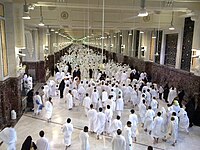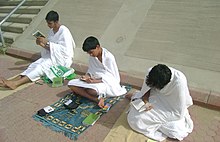Rites
Fiqh literature describes in detail the manners of carrying out the rites of Hajj, and pilgrims generally follow handbooks and expert guides to successfully fulfill the requirements of Hajj.[48] In performing the rites of Hajj, the pilgrims not only follow the model of Muhammad, but also commemorate the events associated with Abraham.[49]
Ihram
Ihram is the name given to the special spiritual state, state of holiness, which marks the start of the ritual of Hajj for each person.[6][50] Ihram is initiated upon the arrival to the Miqat or prior to reaching it, depending on where they have come from.
When a pilgrims enter into the state of Ihram, they are required to abstain from certain actions.[51] While in state of ihram, males are required to wear two white seamless cloths, with one wrapped around the waist reaching below the knee and the other draped over the left shoulder and tied at the right side. For females this involves wearing ordinary dress that fulfills the Islamic condition of public dress with hands and face uncovered;[52][page needed]. Other prohibitions include refraining from clipping the nails, shaving any part of the body, having sexual relations; using perfumes, damaging plants, killing animals, covering head (for men) or the face and hands (for women); getting married; or carrying weapons.[6][50]
The Ihram is meant to show equality of all pilgrims in front of God, with no difference between the rich and the poor.[49] Donning such unsewn white garments entirely is believed to distance man from material ostentation, and engross him in a world of purity and spirituality, since clothes are believed to show individuality and distinction and create superficial barriers that separate individuals. The garments of Ihram are seen as the antithesis of that individualism. Ihram clothing is also a reminder of shrouds worn after death.[53]
First day of Hajj: 8th Dhu al-Hijjah
On the 8th Dhu al-Hijjah, the pilgrims are reminded of their duties. They again don the Ihram garments and confirm their intention to make the pilgrimage. The prohibitions of Ihram start now.
Tarwiyah Day
The 8th day of Dhu al-Hijjah coincides with the Tarwiyah Day. The name of Tarwiyah refers to a narration of Ja'far al-Sadiq. He described the reason that there was any water at Mount Arafat in the 8th day of Dhu al-Hijjah. If pilgrims wanted to stay at Arafat, he would have prepared water from Mecca and carried it by themselves there. So they told each other drink enough. Finally, this day called Tarwiyah[54] that means to quench thirst in the Arabic language.[55] Tarwiyah Day is the first day of Hajj ritual. Also at this day, Husayn ibn Ali began to go to Karbala from Mecca.[56] Muhammad nominated to Tarwiyah Day as one of the four chosen days.[55]
Tawaf and sa'ay

The ritual of Tawaf involves walking seven times counterclockwise around the Kaaba.[57] Upon arriving at Al-Masjid Al-Ḥarām (Arabic: المَسجِد الحَرَام, The Sacred Mosque), pilgrims perform an arrival tawaf either as part of Umrah or as a welcome tawaf.[58] During tawaf, pilgrims also include Hateem – an area at the north side of the Kaaba – inside their path. Each circuit starts with the kissing or touching of the Black Stone. Pilgrims also point to the stone and recite a prayer. (Hajar al- Aswad).[59] If kissing or touching the stone is not possible because of crowds, pilgrims may simply point towards the stone with their hand on each circuit. Eating is not permitted but the drinking of water is permitted and encouraged, because of the risk of dehydration. Men are encouraged to perform the first three circuits at a hurried pace, known as Ramal, and the following four at a more leisurely pace.[52][page needed][59]
The completion of Tawaf is followed by two Rakaat prayers at the Place of Abraham (Muqam Ibrahim), a site near the Kaaba inside the mosque.[59][60] However, again because of large crowds during the days of Hajj, they may instead pray anywhere in the mosque. After prayer, pilgrims also drink water from the Zamzam well, which is made available in coolers throughout the Mosque.[61]
Although the circuits around the Kaaba are traditionally done on the ground level, Tawaf is now also performed on the first floor and roof of the mosque because of the large crowds.
This rite is said to be the manifestation of Tawhid, the Oneness of God. The heart and soul of the pilgrim should move around Kaaba, the symbol of the House of God, in a way that no worldly attraction distracts him from this path. Only Tawhid should attract him. Tawaf also represents Muslims' unity. During Tawaf, everyone encircles Kaaba collectively.[53]
Tawaf is followed by sa'ay, running or walking seven times between the hills of Safa and Marwah, located near the Kaaba.[57][60] Previously in the open air, the place is now entirely enclosed by the Sacred Mosque, and can be accessed via air-conditioned tunnels.[62] Pilgrims are advised to walk the circuit, though two green pillars mark a short section of the path where they run. There is also an internal "express lane" for elderly or disabled people. After sa'ay, male pilgrims shave or trim their hair and women generally clip a portion of their hair, which completes the Umrah.
Mina
After the morning prayer on the 8th of Dhu al-Hijjah, the pilgrims proceed to Mina where they spend the whole day and offer noon (Note: On Friday, Friday Prayer is Offered, instead of Dhuhr Prayer, at Mina), afternoon, evening, and night prayers.[63] The next morning after morning prayer, they leave Mina to go to Arafat.
Second day: 9th Dhu al-Hijjah
The 9th Dhul-Hijjah is known as Day of Arafah, and this day is called the Day of Hajj.[45]
Arafat
On 9th Dhu al-Hijjah before noon, pilgrims arrive at Arafat, a barren and plain land some 20 kilometres (12 mi) east of Mecca,[64] where they stand in contemplative vigil: they offer supplications, repent on and atone for their past sins, and seek the mercy of God, and listen to the sermon from the Islamic scholars who deliver it from near Jabal al-Rahmah (The Mount of Mercy)[63] from where Muhammad is said to have delivered his last sermon. Lasting from noon through sunset,[64] this is known as 'standing before God' (wuquf), one of the most significant rites of Hajj.[6] At Masjid al-Namirah, pilgrims offer noon and afternoon prayers together at noontime.[63] A pilgrim's Hajj is considered invalid if they do not spend the afternoon on Arafat.[12][64]
Muzdalifah
Pilgrims must leave Arafat for Muzdalifah after sunset without performing their maghrib (sunset) prayer at Arafat.[65] Muzdalifah is an area between Arafat and Mina. Upon reaching there, pilgrims perform Maghrib and Isha prayer jointly, spend the night praying and sleeping on the ground with open sky, and gather pebbles for the next day's ritual of the stoning of the Devil (Shaytan).[66]
Third day: 10th Dhu al-Hijjah
After returning from Muzdalifah, the Pilgrims spend the night at Mina.
Ramy al-Jamarat
Back at Mina, the pilgrims perform symbolic stoning of the devil (Ramy al-Jamarat) by throwing seven stones from sunrise to sunset at only the largest of the three pillars, known as Jamrat al-Aqabah.[12][67][self-published source?] The remaining two pillars (jamarah) are not stoned on this day.[68] These pillars are said to represent Satan.[69] Pilgrims climb ramps to the multi-levelled Jamaraat Bridge, from which they can throw their pebbles at the jamarat. Because of safety reasons, in 2004 the pillars were replaced by long walls, with catch basins below to collect the pebbles.[70][71]
Animal
After the stoning of the Devil, animals are sacrificed to commemorate the story of Ibrahim and Ismael. Traditionally the pilgrims slaughtered the animal themselves or oversaw the slaughtering. Today many pilgrims buy a sacrifice voucher in Mecca before the greater Hajj begins, which allows an animal to be slaughtered in the name of God (Allah) on the 10th, without the pilgrim being physically present. Modern abattoirs complete the processing of the meat, which is then sent as a charity to poor people around the world.[12][62] At the same time as the sacrifices occur at Mecca, Muslims worldwide perform similar sacrifices, in a three-day global festival called Eid al-Adha.[13]
Hair removal
After sacrificing an animal, another important rite of Hajj is the shaving or trimming of head hair (known as Halak). All male pilgrims shave their head or trim their hair on the day of Eid al Adha and female pilgrims cut the tips of their hair.[72][73][74]
Tawaf Ziyarat
On the same or the following day, the pilgrims re-visit the Sacred Mosque in Mecca for another tawaf, known as Tawaf al-Ifadah, an essential part of Hajj.[73] It symbolizes being in a hurry to respond to God and show love for Him, an obligatory part of the Hajj. The night of the 10th is spent back at Mina.
Fourth day: 11th Dhu al-Hijjah
Starting from noon to sunset on the 11 Dhu al-Hijjah (and again the following day), the pilgrims again throw seven pebbles at each of the three pillars in Mina. This is commonly known as the "Stoning of the Devil".[67]
Fifth day: 12th Dhu al-Hijjah
On 12 Dhu al-Hijjah, the same process of the stoning of the pillars as of 11 Dhu al-Hijjah takes place.[67] Pilgrims may leave Mina for Mecca before sunset on the 12th.
Last day at Mina: 13th Dhu al-Hijjah
If unable to leave on the 12th before sunset or opt to stay longer, they must perform the stoning ritual again on the 13th before returning to Mecca.[67]
Tawaf al-Wadaa
Finally, before leaving Mecca, pilgrims perform a farewell tawaf called the Tawaf al-Wadaa. 'Wadaa' means 'to bid farewell'. The pilgrims circle the Kaaba seven times counter-clockwise, and if they can, attempt to touch or kiss the Kaaba.[12]
Journey to Medina
An optional part of Hajj where pilgrims may choose to travel to the city of Medina (approximately 450 kilometres (280 mi) to the northeast) and the Al-Masjid an-Nabawi (Mosque of the Prophet), which contains Muhammad's tomb.[62] The Quba Mosque and Masjid al-Qiblatayn are also usually visited.[75








No comments:
Post a Comment